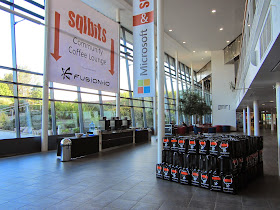SQLBits XII held at The International Centre, Telford between 17-19 July was an event that made history and will be the talk of the town for years to come. A big thank you needs to go the committee, speakers, delegates, sponsors and helpers.This is the forth year I have helped a SQLBits and it is always such a privilege to help at the event.
The session content stretched the breath and depth of the SQL Server platform from Big Data Analytics, Business Intelligence, Development and Administration.
I spent the training day at
the Real World Big Data-Deploy, Design
and Manage like a Pro session with Adam Jorgensen and John
Welch. The session linked Hadoop to BI solutions providing examples
in labs culminating in streaming real
time analytics. It was packed full of tips on best practices, configuration
patterns, predictive analytics for the analysts and BI integration for the data
developers. These new technologies allow you to modernize your data architecture.
This was a great practical session.
The keynote was delivered by
Nigel Ellis a Distinguished Engineer in the Database Systems Group at
Microsoft. It continued along the track of previous
technical keynotes starting with an overview of Azure SQL Database
progressing to the technicalities of ring geometry of
distributed computing.
Greatly enjoyed the session on Latches, Spinlocks, and Lock Free Data Structures. It is always fun to delve into this area using sys.dm_os_latch_stats which returns information about all latch waits organized by class.
Microsoft gave a session on In-memory tables which introduced the in-memory technology for optimizing OLTP workloads and gave some key pointers to consider when designing new architectures. There are currently some scope limitations. The document Common Workload Patterns and Migration Considerations is a good source of reference.
There were many, many more sessions delivered by excellent speakers and it is never possible to attend them all. It is good to know the sessions are recorded and will be avaialble later on the SQLBits website.
A few mentioned a useful paper to read by Joseph Sack on the new SQL Server 2014 Cardinality Estimator.The article is entitled Optimizing Your Query Plans with the SQL Server 2014 Cardinality Estimator . This is an important new feature that can make existing plans perform the same, better or worse so it is key to test these changes out. You can use trace flag 2312 and 9481 to test code using the different optimisers. The article Enable plan-affecting SQL Server query optimizer behaviour that can be controlled by different trace flags on a specific-query level describes the flags.
Chaos, complexity, curiosity and database systems. A place where research meets industry
Tuesday, 22 July 2014
Tuesday, 15 July 2014
Pre-SQLBits - Bristol SQL Server User Group - July Meeting
Monday 14 July saw the Bristol User Group meet with Brent Ozar talking on Are AlwaysOn Availability Groups Right for You? It was amazing that Brent came to share his in depth knowledge on AlwaysOn. He shared the pros and cons of what needs to be considered when creating this type of database architecture solution.
Brent has an amazing set of resources covering AlwaysOn. These are found
http://www.brentozar.com/sql/sql-server-alwayson-availability-groups/
The Microsoft guides I found useful were:-
AlwaysOn Architecture Guide: Building a High Availability and Disaster Recovery Solution by Using AlwaysOn Availability Groups
http://msdn.microsoft.com/en-us/library/jj191711.aspx
Microsoft SQL Server AlwaysOn Solutions Guide for High Availability and Disaster Recovery
http://msdn.microsoft.com/en-us/library/ff929171.aspx
Comparison of Failover Cluster Instances and Availability Groups
The core concepts between FCIs and Availability Groups are compared in this table taken from http://msdn.microsoft.com/en-us/library/ff929171.aspx
For more details and caveats see the full article http://msdn.microsoft.com/en-us/library/ff929171.aspx
Thursday, 3 July 2014
Mainstream Support Ends
Taken from http://support.microsoft.com/lifecycle

